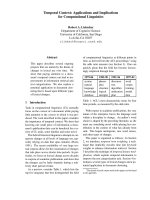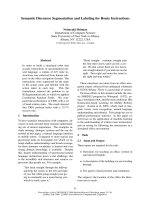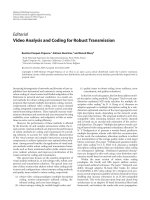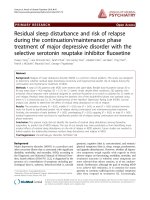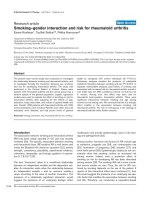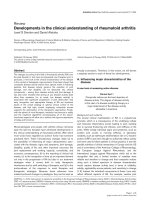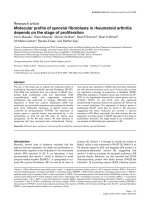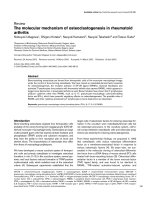Báo cáo y học: "Smoking–gender interaction and risk for rheumatoid arthritis" pot
Bạn đang xem bản rút gọn của tài liệu. Xem và tải ngay bản đầy đủ của tài liệu tại đây (56.84 KB, 5 trang )
R158
Introduction
The association between smoking and rheumatoid arthritis
(RA) has been widely reported [1–21] and was recently
reviewed [20]. The specific association between smoking
and rheumatoid factor (RF)-positive RA is well known and
meets the Bradford Hill criteria for causation [22], namely
strength, consistency, plausibility, experimental evidence,
coherence, temporality, and biologic gradient of associa-
tion [1,7,8,16,17,20].
The term ‘interaction’ refers to a conditional relationship
between an independent variable and the dependent vari-
able. An interaction exists when the relationship between
an independent variable x and an outcome variable y
varies according to the value of another covariate z. The
presence of a statistically significant interaction would
suggest the presence of an underlying biologic effect
modification and provide epidemiologic clues to the etiol-
ogy and pathogenesis [23].
Among women, hormonal risk factors for RA include age
at menarche, progestin use [24], oral contraceptive use
[25], termination of pregnancy [26], lactation [27], and
short fertile period [28]. Epidemiologic studies do not con-
sistently show that smoking confers an increased risk
among women. Indeed, even a protective effect of
smoking on risk for developing RA has been described
among women [29]. The smoking–RA risk is more consis-
tent across studies on men. Thus, the risk for RA con-
ferred by smoking depends on the sex of the patient. If
reports of this interaction effect were confirmed [1], then
this would suggest the presence of an underlying sex-spe-
cific factor that modifies the association between smoking
and RA. Therefore, we conducted a population-based
RA = rheumatoid arthritis; RF = rheumatoid factor.
Arthritis Research & Therapy Vol 5 No 3 Krishnan et al.
Research article
Smoking–gender interaction and risk for rheumatoid arthritis
Eswar Krishnan
1
, Tuulikki Sokka
2,3
, Pekka Hannonen
2
1
Department of Medicine, Stanford University, Palo Alto, California, USA
2
Jyväskylä Central Hospital, Jyväskylä, Finland
3
Vanderbilt University, Nashville, Tennessee, USA
Corresponding author: Eswar Krishnan (e-mail: )
Received: 27 Nov 2002 Revisions requested: 10 Jan 2003 Revisions received: 20 Jan 2003 Accepted: 21 Feb 2003 Published: 24 Mar 2003
Arthritis Res Ther 2003, 5:R158-R162 (DOI 10.1186/ar750)
© 2003 Krishnan et al., licensee BioMed Central Ltd (Print ISSN 1478-6354; Online ISSN 1478-6362). This is an Open Access article: verbatim
copying and redistribution of this article are permitted in all media for any purpose, provided this notice is preserved along with the article's original
URL.
Abstract
The present case–control study was conducted to investigate
the relationship between smoking and rheumatoid arthritis, and
to investigate formally the interaction between sex, smoking,
and risk for developing rheumatoid arthritis. The study was
performed in the Central District of Finland. Cases were
patients with rheumatoid arthritis and the control group was a
random sample of the general population. Logistic regression
models were used to evaluate the effect of smoking on risk for
rheumatoid arthritis, after adjusting for the effects of age,
education, body mass index, and indices of general health and
pain. Overall, 1095 patients with rheumatoid arthritis and 1530
control individuals were included. Patients were older, less well
educated, more disabled, and had poorer levels of general
health as compared with control individuals (all P < 0.01).
Preliminary analyses revealed the presence of substantial
statistical interaction between smoking and sex (P < 0.001). In
separate multivariable analyses, past history of smoking was
associated with increased risk for rheumatoid arthritis overall in
men (odds ratio 2.0, 95% confidence interval 1.2–3.2) but not
in women. Among men, this effect was seen only for
rheumatoid factor-positive rheumatoid arthritis. There were
significant interactions between smoking and age among
women but not among men. We conclude that sex is a biologic
effect modifier in the association between smoking and
rheumatoid arthritis. The role of menopause in the etiology of
rheumatoid arthritis merits further research.
Keywords: etiology, interaction, risk, rheumatoid arthritis, sex, smoking
Open Access
Available online />R159
case–control study, including 1095 patients with RA iden-
tified in the Central Finland RA Database and 1530
control individuals living in the same district.
Patients and method
Cases and controls
Cases were patients drawn from the Central Finland RA
Database, located at the Jyväskylä Central Hospital, which
is the only rheumatology center in the Central District of
Finland (population 263 869 in 2000). All patients were
diagnosed to have RA by their physician. The Central
Finland RA Database includes demographic measures,
treatments, and outcomes of all patients with RA seen in
the clinic since January 1993. As of June 2000, the data-
base contained information on 1763 RA patients, 1495 of
whom were still alive. The control group was a random
sample drawn from the general population. To obtain a
population sample, the names and addresses of 2000
people living in the Central District of Finland were
obtained from the organization Statistics of Finland (with
the permission from the Ministry of Social Affairs and
Health, Finland). Statistics of Finland obtains the majority
of its data from diverse administrative registers, and pro-
duces two-thirds of all Government statistics in Finland
(www.stat.fi). The Ethics Committee of Jyväskylä Central
Hospital approved the study.
Data collection
A questionnaire was mailed to 1495 candidate patients
with RA and to 2000 candidate control individuals in June
2000. A reminder letter was sent 8 weeks later to non-
responders. The response rate for questionnaires among
candidate patients was 73% (n=1095) and that among
candidate control individuals was 77% (1530). Functional
status in activities of daily living was measured using the
Finnish version of the Health Assessment Questionnaire
(score range 0–3) [30]. Pain and global status were
assessed on a 100-mm visual–analog scale (range 0–100
from best to worst). Data on date of birth, height and
weight, sex, years of education, and current and previous
smoking habits (never/ever) were collected. In addition,
clinical features of patients were obtained from the data-
base. Seropositivity for RF (Ig-M) was defined according
to laboratory references (>30kU/l). One of us (TS)
assessed radiographs of hands and feet according to the
Larsen method, and the presence or absence of radiologic
erosions was recorded as a dichotomous variable.
Statistical analysis
Data were analyzed in two stages. The initial stage was to
test the hypothesis that there is a primary interaction
between sex and smoking. This was performed by includ-
ing a pair-wise product term (i.e. smoking×sex) in addition
to the individual variables in a logistic regression model in
which the dependent variable was case versus control
status. The P value calculated for the interaction term in
the logistic regression model was used to determine sta-
tistical significance. If this showed the presence of a sta-
tistically significant interaction, then a second stage of
analyses was performed. In the second stage, parallel
case–control analyses were performed for men and
women using multivariable logistic regression. The inde-
pendent variables in these models were age, education,
body mass index, Health Assessment Questionnaire dis-
ability index, self-reports of pain and overall health assess-
ments, as well as a smoking variable. The last five
covariates were included in the model because these can
potentially confound the smoking–RA relationship. Sepa-
rate regression analyses were performed to assess the
effect of both the smoking variables (current smoking and
past smoking) on the risk for RA. Forward or backward
stepwise selections were not used, and all clinically impor-
tant covariates were included in the multivariable models.
We performed Student’s t-test to compare differences in
mean values and Pearson’s χ
2
test to compare differences
in proportions. Analyses were performed using STATA
®
Version 7.0 software (Stata Corporation, College Station,
TX, USA).
Results
The mean age of the patients was 62 years (range 19–96
years) and 71% were female; the mean age of control indi-
viduals was 55 years (range 30–91 years) and 72% were
female. Among RA patients, the mean disease duration
was 11.3 years (range 0.2–47 years), 68.6% were RF-
positive, and 60% had erosions in their hand or feet radio-
graphs. There were no statistically significant differences
in the proportion of seropositivity for RF (67% versus
71%; P=0.29), frequency of erosive disease (59% versus
60.3%; P=0.84), or disease duration (11.7 years versus
10.5 years; P=0.06) between men and women with RA.
In preliminary logistic regression analyses in which any RA
was the dependent variable of interest, sex exhibited a sta-
tistically significant interaction with current/past smoking
(all P<0.001). Among women there was significant inter-
action between age and past smoking (P=0.01) but not
with current smoking (P=0.13). Among men there were
no statistically significant interactions between age and
current smoking (P=0.12) and age and past smoking
(P=0.97). Subsequent analyses were performed sepa-
rately for men and women.
Table 1 shows comparisons between patients and control
individuals by sex. Among both sexes, patients were older,
less well educated, more disabled, and reported poorer
general health and increased functional disability and pain
in comparison with control individuals. Female patients
were less likely to report past or current smoking than
were female control individuals. Among men, there was no
statistically significant difference in the proportion of
current smokers between patients and control individuals,
Arthritis Research & Therapy Vol 5 No 3 Krishnan et al.
R160
but patients were more likely to have smoked in the past
than were control individuals (Table 1).
In the multivariable models, we adjusted for age, body
mass index, level of education and indices of functional dis-
ability, pain, and general health. Parallel analyses looking at
the effect of smoking on the risk of RA were performed in
subgroups of patients defined by presence or absence of
RF as well as all patients with RA (Tables 2 and 3).
Multivariable analyses for women (Table 2) showed that
there was no significant association between current or
past smoking and RF-positive or RF-negative RA.
Although not statistically significant, the magnitude of risk
was consistently less than 1.0 in both RF-positive and
RF-negative patients with RA.
For men (Table 3), past smoking was consistently associ-
ated with RF-positive RA (odds ratio 2.3, 95% confidence
interval 1.3–3.9). Neither current nor past smoking was
associated with RF-negative RA. Overall, past smoking
(odds ratio 2.0, 95% confidence interval 1.2–3.2) but not
current smoking (odds ratio 1.2, 95% confidence interval
0.7–2.0) was associated with increased risk for RA.
Discussion
In the present study we confirmed the earlier observation
that smoking is a risk factor for RA in men but not in
women [1,17]. In addition, we statistically tested and con-
firmed the interaction between smoking and sex, thereby
providing evidence in support of a biologic interaction
between smoking and RA.
Smoking is known to be associated with production of RF
[6,16,20]; RF production, in turn, often precedes the
development of clinical disease [12,16]. Furthermore, it
appears to be independent of HLA-DR restricted immune
response [13]. In our study, we found that this paradigm
held well for men but not women. Why could it be? One of
the explanations for this could be that the immunologic
cascade triggered by smoking and leading to RF produc-
tion and subsequently to clinical RA is modulated differ-
ently in men and in women. The most obvious biologic
difference between men and women is the hormonal
Table 1
Comparison between patients with rheumatoid arthritis and control individuals according to sex
Women Men
Parameter RA cases Controls RA cases Controls
(n = 777) (n = 1104) P (n = 318) (n = 426) P
Age in years (mean ± SD) 62 ± 13 56 ± 15 <0.001 63 ± 12 53 ± 14 <0.001
Education in years (mean ± SD) 9.7 ± 3.8 10.9 ± 4.0 <0.001 8.6 ± 3.3 10.8 ± 4.2 <0.001
BMI (kg/m
2
; mean ± SD) 26 ± 4.6 25±4.6 0.54 26 ± 3.8 27±3.7 0.62
Proportion currently smoking (%) 7 14 <0.001 18 21 0.83
Proportion past smokers (%) 16 22 0.02 66 50 <0.001
HAQ disability index (mean ± SD)* 0.89 ± 0.8 0.30 ± 0.6 <0.001 0.68 ± 0.8 0.21 ± 0.5 <0.001
General health VAS (mean ± SD)
†
35.1 ± 22 22.4 ± 22 <0.001 31.8 ± 21 20.8 ± 22 <0.001
Pain VAS (mean ± SD)
†
34 ± 25 21 ± 25 <0.001 29 ± 23 19 ± 23 <0.001
*Health Assessment Questionnaire (HAQ) disability index (range 0–3);
†
visual analog scale (VAS; range 0–100, best to worst). BMI, body mass
index; RA, rheumatoid arthritis.
Table 2
Adjusted odds ratios for developing rheumatoid arthritis
according to smoking and rheumatoid factor status in women
Number of observations entering
the multivariable model
Odds ratio*
Parameter RA cases Controls (95% CI)
All RA
Current smoking 751 1083 0.7 (0.4–1.0)
Past smoking 504 851 0.9 (0.6–1.3)
RF-positive RA
Current smoking 452 1083 0.6 (0.3–1.0)
Past smoking 365 851 0.8 (0.6–1.3)
RF-negative RA
Current smoking 299 1083 0.84 (0.5–1.5)
Past smoking 238 851 0.94 (0.6–1.5)
*Odds ratios are expressed as the expected probability of having
rheumatoid arthritis (RA) as compared with those who did not smoke.
The confounders adjusted for in the multivariable logistic regression
models included age, body mass index, number of years of education,
Health Assessment Questionnaire disability index, general health
assessment, and pain. CI, confidence interval.
milieu, although other sex-specific factors cannot be ruled
out. In our analyses we found a significant age–smoking
interaction among women – an observation that is not
inconsistent with this hypothesis.
Although we were not able to test this hypothesis directly
in our data (because the relevant reproductive variables
were not available), a review of the literature gives some
clues. In studies conducted in women-only cohorts, the
presence of association between smoking and RA
appeared to be dependent on menopausal status of study
participants. In a population-based study conducted in
Iowa, USA, which examined postmenopausal women only,
a dose-dependent effect of smoking was evident (relative
risk for RA for current smokers versus never smokers 2.0)
[11]. On the other hand, data from the prospective Nurses
Health Study [2], which examined all (primarily menstruat-
ing) women aged 30–55 years, did not show a statistically
significant relationship between current or past smoking
and RA. Furthermore, in the Women’s Health Cohort
Study [7], the effect size of smoking was relatively modest
(relative risk 1.39 and 1.49 for all RA and RF-positive RA,
respectively) as compared with that in the Iowa study.
Interpreting our findings of an interaction between
smoking and sex in the light of published data, we
propose that being a menstruating woman acts as a bio-
logic effect modifier that blocks the smoking–RF–RA
pathway. We did not have the information on menopausal
status to test this hypothesis directly. Instead, we con-
ducted multiple pair-wise interaction tests between age
and smoking for men and women separately. Interestingly,
we found that there was a significant age–smoking inter-
action among women but not among men. This
smoking–sex effect modification paradigm we propose not
only might explain a lack of increased risk for RA among
women smokers, but also provides a theoretical basis for
the observation that smoking reduces the risk for RA in
women [29].
There are several areas of substantial strength in the
present study. First, the study participants were drawn from
a population-based register of RA patients (i.e. a rheuma-
tology clinic in which all patients with RA living in the partic-
ular referral area are followed) and the control individuals
were drawn from the same, geographically well-defined
general population. Second, the participation rates for
patients and control individuals were good. Validated diag-
noses and exposures were used. The smoking histories
were also validated using hospital medical records, by
comparing the questionnaire response with the information
from the standard clinical history and physical examination.
Finally, the numerical strength of this study provided suffi-
cient statistical power to quantitate the risk of smoking on
RF-positive and RF-negative RA separately.
The potential limitations of the study also must be
addressed. By design, the study was an unmatched
case–control study. The control individuals were younger
than the cases. Many control individuals were younger
than 50 years. This may lead to arguments that control
individuals were not old enough to have developed RA
and that an age-matched design would have been more
appropriate. However, such a bias does not explain our
observations as the age differential was found in both men
and women. In addition to performing tests of interaction
between age and smoking, we adjusted for the effect of
age in multivariable models. To address the concern that
successive birth cohorts are associated with lower preva-
lence rates of smoking and leading to bias in our findings,
analyses were repeated, adjusting for the effect of calen-
dar year of birth. We found that the results were essen-
tially the same. We believe that matching by age would
have been, overall, disadvantageous to the study because
such an approach would not allow us to study important
interactions between age and other covariates. Unfortu-
nately, data on the temporal sequence of smoking and RA,
as well as on any dose–response association, were not
available and could not be analyzed.
The differences in the risk estimates for current smoking
and past smoking may appear counter-intuitive. The expla-
nation lies in the case–control design of the study. Both
smoking and RA can independently increase the risk for
mortality; the potential patients who are also continuing
smokers are more likely to have died than are smokers in
Available online />R161
Table 3
Adjusted odds ratios for developing rheumatoid arthritis
according to smoking and rheumatoid factor status in men
Number of observations entering
the multivariable model
Odds ratio*
Parameter RA cases Controls (95% CI)
All RA
Current smoking 306 418 1.2 (0.7–2.0)
Past smoking 234 306 2.0 (1.2–3.2)
RF-positive RA
Current smoking 181 418 1.5 (0.8–2.6)
Past smoking 140 306 2.3 (1.3–3.9)
RF-negative RA
Current smoking 125 418 0.8 (0.3–1.8)
Past smoking 94 306 1.5 (0.7–3.0)
*Odds ratios are expressed as the expected probability of having
rheumatoid arthritis (RA) as compared with those who did not smoke.
The confounders adjusted for in the multivariable logistic regression
models included age, body mass index, number of years of education,
Health Assessment Questionnaire disability index, general health
assessment, and pain. CI, confidence interval.
Arthritis Research & Therapy Vol 5 No 3 Krishnan et al.
R162
the general population, thus never entering the study [31].
This differential mortality could have resulted in an under-
estimation of the association between current smoking
and RA. However, it is unlikely that there is a difference in
smoking-related mortality between men and women of
such a magnitude as to cause the observed sex differen-
tial. Another equally plausible explanation would be that
the diagnosis of RA might have led to lifestyle changes,
leading to cessation of smoking. However, there is little
evidence to suggest that onset of RA would affect
smoking behavior in men and women in a different manner
(i.e. there is no published literature or rationale for suppos-
ing that men and women tend to take up or quit smoking
differently when they develop RA).
Conclusion
Data presented in this report suggest that factors related
to the sex of an individual modify the effect of smoking on
the risk of RA. Epidemiologic studies that do not explore
and account for the significant smoking–sex interaction
are likely to show inaccurate and even biased estimates of
the association between smoking and RA. Our study also
highlights the need for further research on smoking, RA,
and, in addition, their effect modification by sex-related
factors like menopause.
Competing interests
None declared.
References
1. Heliovaara M, Aho K, Aromaa A, Knekt P, Reunanen A: Smoking
and risk of rheumatoid arthritis. J Rheumatol 1993, 20:1830-
1835.
2. Hernandez Avila M, Liang MH, Willett WC, Stampfer MJ, Colditz
GA, Rosner B, Roberts WN, Hennekens CH, Speizer FE: Repro-
ductive factors, smoking, and the risk for rheumatoid arthritis.
Epidemiology 1990, 1:285-291.
3. Houssien DA, Scott DL, Jonsson T: Smoking, rheumatoid factors,
and rheumatoid arthritis. Ann Rheum Dis 1998, 57:175-176.
4. Hutchinson D, Shepstone L, Moots R, Lear JT, Lynch MP: Heavy
cigarette smoking is strongly associated with rheumatoid
arthritis (RA), particularly in patients without a family history
of RA. Ann Rheum Dis 2001, 60:223-227.
5. Hutchinson D, O’Leary C, Nixon NB, Mattey DL: Serum com-
plexes of immunoglobulin A-alpha1 proteinase inhibitor in
rheumatoid arthritis: association with current cigarette smoking
and disease activity. Clin Exp Rheumatol 2002, 20:387-391.
6. Jonsson T, Thorsteinsson J, Valdimarsson H: Does smoking
stimulate rheumatoid factor production in non-rheumatic indi-
viduals? APMIS 1998, 106:970-974.
7. Karlson EW, Lee IM, Cook NR, Manson JE, Buring JE, Hennekens
CH: A retrospective cohort study of cigarette smoking and
risk of rheumatoid arthritis in female health professionals.
Arthritis Rheum 1999, 42:910-917.
8. Khaw KT, Tazuke S, Barrett-Connor E: Cigarette smoking and
levels of adrenal androgens in postmenopausal women. N
Engl J Med 1988, 318:1705-1709.
9. Masdottir B, Jonsson T, Manfredsdottir V, Vikingsson A, Brekkan
A, Valdimarsson H: Smoking, rheumatoid factor isotypes and
severity of rheumatoid arthritis. Rheumatology (Oxford) 2000,
39:1202-1205.
10. Dai WS, Gutai JP, Kuller LH, Cauley JA: Cigarette smoking and
serum sex hormones in men. Am J Epidemiol 1988, 128:796-805.
11. Criswell LA, Merlino LA, Cerhan JR, Mikuls TR, Mudano AS,
Burma M, Folsom AR, Saag KG: Cigarette smoking and the risk
of rheumatoid arthritis among postmenopausal women:
results from the Iowa Women’s Health Study. Am J Med 2002,
112:465-471.
12. Aho K, Heliovaara M, Maatela J, Tuomi T, Palosuo T: Rheumatoid
factors antedating clinical rheumatoid arthritis. J Rheumatol
1991, 18:1282-1284.
13. Mattey DL, Dawes PT, Clarke S, Fisher J, Brownfield A, Thomson
W, Haajeer AH, Ollier WE: Relationship among the HLA-DRB1
shared epitope, smoking, and rheumatoid factor production in
rheumatoid arthritis. Arthritis Rheum 2002, 47:403-407.
14. Silman AJ, Newman J, MacGregor AJ: Cigarette smoking
increases the risk of rheumatoid arthritis. Results from a
nationwide study of disease-discordant twins. Arthritis Rheum
1996, 39:732-735.
15. Symmons DP, Bankhead CR, Harrison BJ, Brennan P, Barrett EM,
Scott DG, Silman AJ: Blood transfusion, smoking, and obesity
as risk factors for the development of rheumatoid arthritis:
results from a primary care-based incident case–control study
in Norfolk, England. Arthritis Rheum 1997, 40:1955-1961.
16. Tuomi T, Heliovaara M, Palosuo T, Aho K: Smoking, lung function,
and rheumatoid factors. Ann Rheum Dis 1990, 49:753-756.
17. Uhlig T, Hagen KB, Kvien TK: Current tobacco smoking, formal
education, and the risk of rheumatoid arthritis. J Rheumatol
1999, 26:47-54.
18. Vessey MP, Villard-Mackintosh L, Yeates D: Oral contraceptives,
cigarette smoking and other factors in relation to arthritis.
Contraception 1987, 35:457-464.
19. Voigt LF, Koepsell TD, Nelson JL, Dugowson CE, Daling JR:
Smoking, obesity, alcohol consumption, and the risk of
rheumatoid arthritis. Epidemiology 1994, 5:525-532.
20. Albano SA, Santana-Sahagun E, Weisman MH: Cigarette
smoking and rheumatoid arthritis. Semin Arthritis Rheum
2001, 31:146-159.
21. Masi AT: Sex hormones and rheumatoid arthritis: cause or
effect relationships in a complex pathophysiology? Clin Exp
Rheumatol 1995, 13:227-240.
22. Hill AB: The environment and disease: association or causa-
tion? Proc R Soc Med 1965, 58:295-300.
23. Greenland S, Rothman K: Concepts of interaction. In Modern
Epidemiology, 2nd ed. Edited by Greenland S. Philadelphia: Lip-
pincott, Williams and Wilkins; 1998:329-342.
24. Koepsell TD, Dugowson CE, Nelson JL, Voigt LF, Daling JR: Non-
contraceptive hormones and the risk of rheumatoid arthritis
in menopausal women. Int J Epidemiol 1994, 23:1248-1255.
25. Brennan P, Bankhead C, Silman A, Symmons D: Oral contracep-
tives and rheumatoid arthritis: results from a primary care-
based incident case–control study. Semin Arthritis Rheum
1997, 26:817-823.
26. Carette S, Surtees PG, Wainwright NW, Khaw KT, Symmons DP,
Silman AJ: The role of life events and childhood experiences in
the development of rheumatoid arthritis. J Rheumatol 2000,
27:2123-2130.
27. Brun JG, Nilssen S, Kvale G: Breast feeding, other reproductive
factors and rheumatoid arthritis. A prospective study. Br J
Rheumatol 1995, 34:542-546.
28. Reckner Olsson A, Skogh T, Wingren G: Comorbidity and
lifestyle, reproductive factors, and environmental exposures
associated with rheumatoid arthritis. Ann Rheum Dis 2001,
60:934-939.
29. Hazes JM, Dijkmans BA, Vandenbroucke JP, de Vries RR, Cats A:
Lifestyle and the risk of rheumatoid arthritis: cigarette
smoking and alcohol consumption. Ann Rheum Dis 1990, 49:
980-982.
30. Hakala M, Nieminen P, Manelius J: Joint impairment is strongly
correlated with disability measured by self-report question-
naires. Functional status assessment of individuals with
rheumatoid arthritis in a population based series. J Rheumatol
1994, 21:64-69.
31. Goodson NJ, Wiles NJ, Lunt M, Barrett EM, Silman AJ, Symmons
DP: Mortality in early inflammatory polyarthritis: cardiovascu-
lar mortality is increased in seropositive patients. Arthritis
Rheum 2002, 46:2010-2019.
Correspondence
Eswar Krishnan, MD MPhil, Stanford University, Division of
Immunology, Department of Medicine, 1000 Welch Road, Suite 203,
Palo Alto, CA 94304, USA. Tel: +1 650 776 6484; e-mail:

